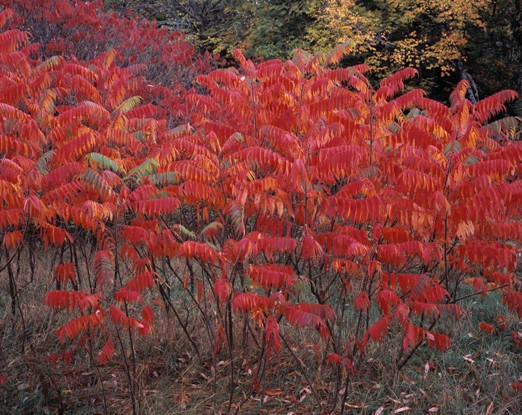
It has been an exciting year with the reissuing of Pat Armstrong’s Wild Plants Family Cookbook. Working with Pat and adapting her recipes from plants found in my own backyard, has given me real respect for where my family’s food comes from. We have a one acre yard that has many types of gardens and plants and a notable species is our beautiful stand of Staghorn Sumac. A native sumac, (Rhus typhina) that was used extensively by Native Americans for food, medicine, and as a source of dye pigments and tannic acid to tan animal hides, grows majestically from an out of the way area in our yard.
Late summer into autumn is when the “horns” are ripe. They are a deep mahogany red color that when brewed in cold water makes an incredible pink lemonade type of beverage that is high in vitamin C. A tea made from the boiled drupes mixed with a sweetener makes a soothing drink for a sore throat.
Sumac plants are also useful as dye plants. The branches, leaves and berries can all be useful rendering a beige brownish-pink. The drupes, a fuzzy seed covering, yield a beige dye in alum mordant and the tannic acid make the dye bath that is fairly permanent. The leaves give a brown-red dye when harvested in the fall after their color change.
A natural source of tannic and malic acid, the leaves can be gathered, dried and used in dye projects and home-tanning leather or fixing natural dye. The tannic acid content of the dried leaves can be as high as 33 %! I have a stash of dried leaves for my fabric dying hobby.
Pat’s recipe for Indian Lemonade Sumac-ade or Rhus Juice:
3-4 quarts water (a gallon sun tea brewer works well)
1-2 clusters Staghorn sumac drupes (berries)
2 cups sugar (or 1 ½ cups honey, Stevia or other natural sweetener to taste)
Put ½ gallon cold water in a large bowl or bucket and add sumac berries. Break branches apart and remove twigs. Mash and crush berries with a potato masher. Add water and pour through a linen towel to strain out seeds and small twigs. Add the rest of water and approximately 2 cups of sugar to taste. Freeze in gallon plastic milk jug or keep in the refrigerator (keeps about 2 weeks then becomes moldy). The color should be a clear pink or peach color.
Caron Wenzel is the owner of Blazing Star Inc. a native plant seed nursery and environmental consulting and education business. The web site is Blazing-Star.com and Pat’s eBook and PDF is available from the site.
Related Articles & Free Email Newsletter
Fall is the Time to Plant Garlic
Sunflower Greens, the Super Food!




Comment here